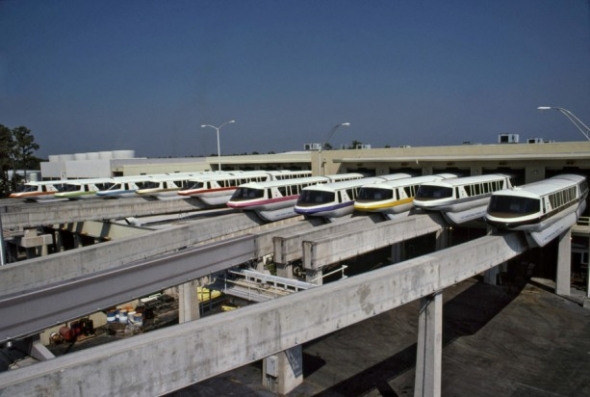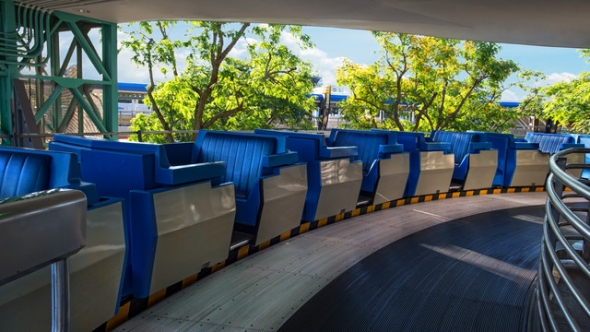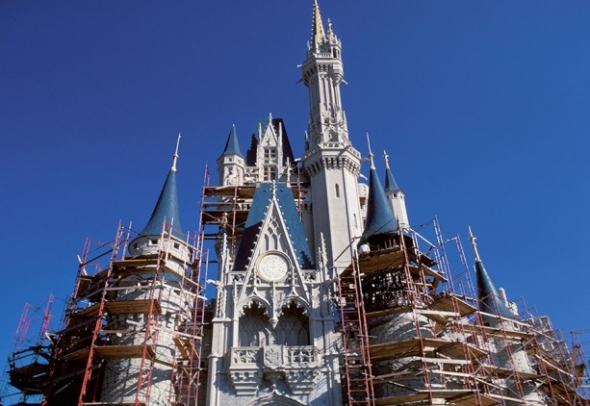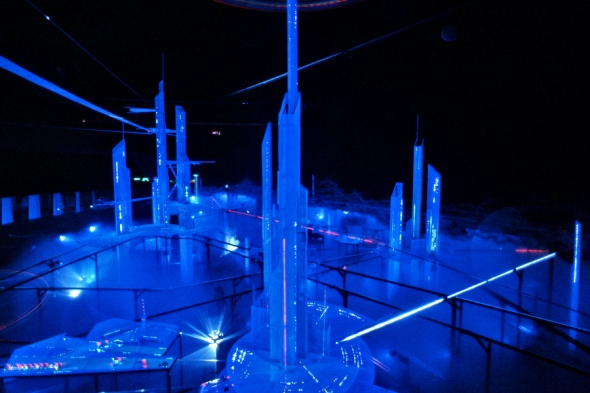Space age transportation and the art of the compromise
Image: Disney
The original E.P.C.O.T. announcement included plans to bring guests to a hub entitled E.P.C.O.T. Transportation Lobby. That obviously doesn't exist, but there are variations of it thanks to the Magical Express pick-up at Orlando International Airport. Plus, there is a Transportation and Ticket Center that shares a parking lot with Disney’s Polynesian Village Resort that hosts many of the intended duties of the Transportation Lobby, albeit with a critical difference. The E.P.C.O.T. version would have connected underground driving with main level monorail transportation. That was one of the first ideas to fall by the wayside when Roy Disney took over the project. Another concept from the announcement is handled fairly well today. Uncle Walt had the original idea to greet guests in their own languages. While that’s a functional impossibility to date, Walt Disney World stands apart as one of the most inclusive vacation destinations in the world. Bilingual greeters oftentimes do introduce themselves to foreign travelers in their own languages, even if hello and welcome to Disney are the only phrases they know.
With regards to the larger issues of transportation logistics, Roy Disney and the Imagineers had to come up with a Plan B in the wake of his brother’s demise. Part of it was obvious, while another key component required a bit of trust in the eventual customer base. The unmistakable choice was that the monorail would become a key ingredient crisscrossing the Florida land. People already associated the Disney theme park brand with Uncle Walt’s favored form of transportation. The Florida Project would seem like a pale imitation of Disneyland, much less the development Disney himself promised, if it lacked a monorail. Its inclusion was a foregone conclusion even as Disney execs agonized over how to implement as many their founder’s promises as possible in the new locale.
Image: Disney
The part that needs people to show some understanding is the People Mover. Today, Walt Disney World aficionados know it as Tomorrowland Transit Authority PeopleMover, aka the best place to nap at Magic Kingdom. Disneyland fanatics fondly remember it as the WEDWay PeopleMover, an attraction that lasted from 1967 to 1995 before Disney foolishly closed it in favor of Rocket Rods, one of the least popular Disney rides of all time. Walt Disney himself forecasted grander plans for the concept he perfected at the 1964 World’s Fair. He wanted it to become a Jetsons-esque space age kind of moving sidewalk that guests would habitually utilize to move about the new city.
The idea was that the monorail would take people across vast distances quickly. The WEDWay (as it was called in the announcement video) would carry guests the rest of the way to their homes, to local shopping, or to their place of employment. Walt Disney understood all the potential benefits and concerns of this kind of transportation, and he had specific ideas about how to bring them to fruition. His death fundamentally ended those plans.
To put this situation in modern terms, imagine if Elon Musk had died prior to building the batteries that power the Tesla automobile. Without him, the remaining staff at Tesla Motors might have had every intention of making his dream a reality. Unfortunately, they lacked the know-how and technical ingenuity to complete the feat. Even though Disney himself had only been a part of the crew that developed the PeopleMover for the World’s Fair, he was the one with the grand ambition about how to forcibly evolve this technology into a basic part of living in the prototype community.
Image: Disney
In the absence of their leader, Imagineers could have built a much larger WEDWay to transport people across the tens of thousands of acres of land Disney owned in Orlando. What would have been the point, though? Everyone realized that the city as envisioned was now impossible. That negated the need for such localized vehicles that were functionally multi-directional elevators. Rather than ignore Disney’s vision entirely, however, they eventually showed respect for their roots by adding the PeopleMover at Magic Kingdom in 1975.
The question of why they waited until four years after the park’s opening to introduce such an iconic part of the original plans for E.P.C.O.T. once bothered me and might annoy you. In reality, the answer is simple. It all came down to financing. Finding the money to pay for all the new developments at Walt Disney World played out as a never-ending shell game for Disney execs. In the end, they settled on the same strategy that Walt Disney himself had accepted in the months leading up to the announcement of The Florida Project. They needed new revenue streams to come from somewhere. And the where was readily apparent.
East Coast Disneyland
Image: Disney
As mentioned in part one, a theme park wasn’t part of the original blueprints for E.P.C.O.T. While the impetus for this East Coast development was an attempt to provide Disney’s brand of family entertainment to people east of the Mississippi River, Uncle Walt considered another Disneyland a lateral move. That’s why many of the rumored developments in New York and Missouri never got off the ground.
Once Disney acquired land in central Florida, the calculus changed only in that the business needed revenue to offset the hefty price tag of all the new acreage. Disney himself didn’t even pitch a theme park at first. It was only after pressure from his board of directors that he relented on the subject. They sagely pointed out that a Floridian answer to Disneyland would earn enough money to finance the more ambitious plans contained in Project X.
For his part, Uncle Walt planned to monetize through different means. His idea of a business haven nestled in the heart of a utopia seemed reasonable due to his previous achievements in conquering the business world. The board felt that it was a needless risk that they could easily mitigate by giving the people what they wanted. Disney ceded to this request, but he never warmed to it. The design of E.P.C.O.T. purposefully forced people to travel through the new elements of the city prior to reaching their presumed tourist destination, the theme park. It was Walt’s way of making people eat their vegetables before getting dessert. Alas, everything changed with his death.





Comments
I remember reading, sometime around 1973, in Time or Life or one of those magazines, an article examining the EPCOT that was built versus the one Walt had imagined. One executive summed it up this way: "Maybe Walt could have done it. Built a fully operating city/community of the future. But try as we might, we couldn't ... if it COULD have been done, only Walt could have done it."
This is the best, informative, and interesting article I have seen in months. I am a huge Disneyana reader. Thank you! My next trip is in 2 weeks and this reminded me of my appreciation for all things"Walt".